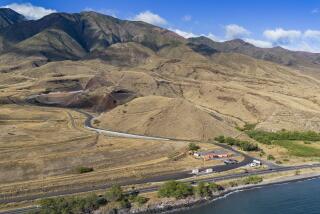Simply sacred
- Share via
Dawn comes to Maui on the slow turn of the Earth’s wheel. A few incendiary hints produce a fragile semi-darkness, then a touch of pink, and finally the day nudges and the night politely steps aside. The onrushing light reveals a solitary church set amid acres of open grass on a point reaching out into Haleki’i Bay.
Hui Aloha Congregational Church was restored in the 1970s, the Pacific trade winds having thrown themselves against the stone rectangle since it was built in 1859, trying to penetrate its 2-foot-thick walls. The four islands of Maui County are dotted with other such simple houses of worship. Many of them bear the unmistakable footprint of New England and Congregationalism--plain, unadorned structures that breathe Puritanism. The Catholics and the Mormons who came after the first missionaries also built simple churches with roofs pitched like praying hands and steeples pointing the way to heaven. I am entranced by them all; for me, they enhance the allure of this special spot.
To be sure, there are similar buildings scattered around mainland America. What makes Hawaiian churches unique is that in their unadorned beauty, they are an embodiment of aloha--that overused, misused, abused word that to outsiders merely means hello or goodbye, but to Hawaiians is a state of mind that summons generosity, tolerance, spontaneity, compassion and creativity.
In their simplicity of line and construction, each is an uplifting work of art, intended for all, including nonbelievers like me. In their presence, heaven seems close at hand. They stand in sharp contrast to the brawny, grim, gray cathedrals of Europe, whose flying buttresses and mountains of organ pipe have always seemed to me like an architectural strategy to humble mankind. In this era of megachurches, with 10,000-member congregations worshiping in sprawling buildings that house day-care centers, gift shops and exercise rooms, Hawaiian churches are a link to the days that were. They are not mere historical sites; most of them have active congregations that maintain them as centers of community and tradition. They are still the gathering point for baptisms, marriages, funerals. The doors are left open as a gesture of trust and welcome to everyone.
It’s often said disparagingly that the Christian missionaries came to Hawaii to do good--and instead they did well. True enough, but one of the legacies of their churches is the survival of the Hawaiian language, which was officially banned in the schools by the territorial government about 100 years ago. The church became the only institution where Hawaiian was spoken, and today Hawaiian and English are now the dual official languages of the 50th state, and it is being taught in public schools and spoken at official functions.
On a Sunday morning I stood in the doorway of Hui Aloha Church. Some 40 people listened to a minister clad in an aloha shirt and lei. The altar was bedecked with anthurium, bird of paradise, protea and ginger. Sunlight streamed through the windows like good news. Two rows of six simple wooden pews formed an aisle that led to an altar inscribed with the Hawaiian translation of a verse from Corinthians: KA MANAOIO KA MANAOLANA A ME KEALOHA KEALOHA NO NAE KAI OI AE. Right underneath was another inscription: If ye seek me ye shall find me.
The impress of faith seemed everywhere, and I sensed the joyous fellowship of people who believe that Adam and Eve were real people, not just symbols, and that the Red Sea parted precisely as the Bible describes it. They bowed their heads briefly in solemn discourse with the Almighty, and then they were on their feet. Throats were cleared. The keyboardist thumbed her book. The collective voices lifted the Hawaiian words of “Amazing Grace” off the pages of the hymnals. The music filled the room like water and became the single, melting voice of the congregation.
As the faithful emerged from church, I retreated to the cemetery--a little metropolis of the dead. Lava tombstones huddled under the branches of a palm tree, and blossoms littered the ground like confetti. Some inscriptions carried a whiff of tragedy--graves dug too soon for people who were too young. An old man, his face a battlefield of wrinkles, approached me and said, “These are the fortunate ones--all with the Lord in heaven.”
“I see,” I said, trying to.
I left well-wished by his smile. To the south, the immense blue fabric of the Pacific was loppy-waved, rumpled and creased, and it seemed to swallow the sky. An about-face revealed Haleakala volcano, dormant and magnificent, robed in the morning mists. All thoughts left my head, and the landscape filled it. The land seemed strummed, throbbing--as though touched by an unseen hand.


